[
{
"name": "Top Stories Video Pair",
"insertPoint": "7",
"component": "17087298",
"parentWrapperClass": "fdn-ads-inline-content-block",
"requiredCountToDisplay": "1"
}
]
Where did you get that laminated, oversized piece of paper with the words "Tweeker Hunting Permit," on it, the one taking up most of the back window of your car? Did you order it online? Or did you make it yourself? If you made it yourself, tell us about that trip to the copy shop. How did the clerk react when you asked for help making a novelty car accessory that advertises your interest in shooting your fellow human beings?
Let's start with spelling. Tweak is the verb, tweeker is the noun. There has been no academic study into the etymology of tweaking and tweekers, but the practical use fits. Tweekers seem to enjoy tweaking with bits of machinery when they're tweaking on tweak. That double-e sound in tweeker is a unique bit of onomatopoeia: a high screechy sound that evokes panic, overwrought synapses and furiously grinding teeth. It's an evocative word, tweeker, one that lends itself easily to a slur's primary purpose: to make its subject seem subhuman.
We allow ourselves to make addicts the brunt of our darkest jokes because of what we think they represent. Those decrepit motels on Broadway. The sick, wired fear in your stomach as a scrawny form skitters in front of your moving car. Our deepest fears of poverty and degradation: ruined teeth, sunken cheeks, shopping carts. But hatred is more acceptable than fear, and this hatred is the oldest story told.
As advanced as we've become as a society, in many ways, we haven't risen above the tribal instinct to cast our sick out to die. Addiction is a disease. The brain of an addict, whether they are addicted to meth, alcohol, gambling or sex, is physically different from that of a non-addict. The dopamine release system (dopamine is that feel-happy chemical you've heard about) is literally hijacked by an addict's drug of choice. This happens along the same primitive mechanisms that control our desire to sleep, eat and procreate. When an addicted brain does not get its chemical of choice, it basically sends out alarm signals saying it's going to die if it doesn't, the same way it would if we were denied food.
Yes, you are tooling around in your Eugenics Wagon threatening to shoot ill people.
But jeez lady, I hear you whining, tweekers suck. They steal shit. They stole my FedEx package off my porch. They dump chemicals in creeks. They scare my kids. They're scabby and gross.
To which I say: yes. You're probably right. It probably was someone addicted to meth who stole your FedEx package. Probably. There seem to be a whole lot of people addicted to methamphetamines in Humboldt County. Addicts who need money often do immoral things. If your brain screams at you that you're never going to be happy again and you're going to die unless you get some money and score really, really soon, do you think you might do some immoral things? Probably.
I realize that it's really hard to explain addiction to non-addicts in a way that creates empathy. Understand that no one will say an immoral act is less wrong because it was an addict who committed it. And a person in the midst of the paranoia and rage that typify meth psychosis is hard to love. But every addict was someone's beautiful baby boy or little girl at some point. They're people. The ability to make moral decisions is a gift. Having a disease that takes away that ability is a tragedy.
Look at it this way: if there was a giant ray gun hovering over Humboldt County, randomly hitting your community members and turning them into scary people, what would be the most effective way to handle it? Would you dismantle the ray gun? Would you exterminate the people it hit? Or would you handle it the way most people seem to address addiction — by grumbling about the damned ray gun and wishing it would disappear on its own and blaming everyone it did hit for being too weak to resist it?
I am delighted to inform you that addressing addiction is a little simpler than dismantling a fictional ray-gun in the sky. We have the tools. We have the science. We have the people. And we have the proof that it works. Recovered addicts walk among us, living miracles.
Addiction is poorly understood and incredibly isolating. Telling an addict that, if they were stronger, they could put down the pipe, put on a tie and go get a position as a pillar of society right now is unproductive. The moral model of addiction is futureless. Conversely, to explain to someone addicted to drugs that they are suffering from a chemical imbalance that has a cure (treatment, support, recovery) can be empowering. It can be equally empowering to community members once they understand that resources directed toward the correct entities can yield real results. Children who grow up in addicted homes often become addicts themselves. Whether it's due to exposure or genetic predisposition is matter of debate. Prevention programs have been shown to be very effective, but they're also usually the most poorly funded. Much more money goes into "reforming" addicts through the penal system, shown to be the least effective measure. Doesn't it make more sense to arrest the cycle rather than the person?
The availability of resources for addicts is often talked about in terms of beds available at treatment centers (about 60 between three different local programs), but those numbers are deceptive. Even if there's a bed open, an addict may not be eligible for it. The county no longer subsidizes detox for methamphetamine users, for example, because there's no medication available to ease them through withdrawal. A user wanting to get clean has to cough up $246 first.
Eric Davis, manager at Alcohol and Drug Care Services, says Humboldt County needs a dedicated program just for methamphetamine users. A residential program specifically targeting this population would help fill the gap.
My own experiences working with addicts in Humboldt County has taught me that getting clean is one thing and staying clean is another. Recovering addicts routinely struggle with mental health problems, systemic poverty, housing insecurity and childcare. Grants and programs pop up all of the time to treat these issues, then disappear the next year as funding withers. To really solve Humboldt County's "meth problem," we need a holistic approach that hinges on treating addicts as humans, not as semi-feral public nuisances to be threatened, laughed about or ignored.
So we've covered it all: spelling, brain chemistry, crime, empathy, ray-guns, primary, secondary, tertiary prevention and some concrete solutions. You should be ready to go out and make a difference. If this is all a little over your head, have someone read you the following sentence:
Stop threatening to shoot your fellow human beings, jerk.
Linda Stansberry is a local freelance journalist and a certified drug and alcohol counselor in California. She lives in Honeydew.
Have something you want to get off your chest? Think you can help guide and inform public discourse? Then the North Coast Journal wants to hear from you. Contact the Journal at [email protected] to pitch your column ideas.
For a look at the Jan. 23 community meeting on meth, read Heidi Walters' "Taking on Meth," which details both the meeting's inspiration and offers a former addict's take.
Speaking of...
-

CA Legislature Mulls Expanding Paid Sick Leave
Jul 11, 2023 -

Drug Task Force: 12 Pounds of Meth Seized in Fortuna
Jun 22, 2023 -

Yurok Tribe, Marshals Service Form MMIP Partnership
Feb 21, 2023 - More »
Comments (3)
Showing 1-3 of 3
more from the author
-
Lobster Girl Finds the Beat
- Nov 9, 2023
-
Tales from the CryptTok
- Oct 26, 2023
- More »
Latest in Views
Readers also liked…
-
Hope
- Sep 7, 2023
-
California Says No to Privatizing Medicare
- Sep 21, 2023

































